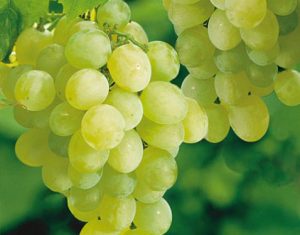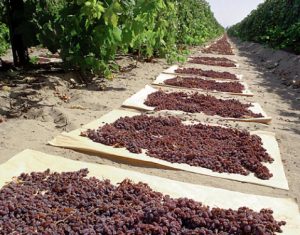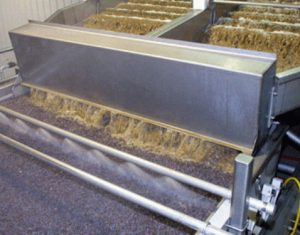 The primary raw material for making raisins is grapes. To make one lb. (453.59 g) of raisins, over four lbs. (1,814.36 g) of fresh grapes are required. These grapes must have certain qualities in order to produce quality raisins. For example, they must ripen early and be easy to dry. Additionally, they must have a soft texture, not stick together when stored, have no seeds, and have a pleasing flavor. The most important grapes for raisin production include Thompson Seedless, Black Corinth, Fiesta, Muscats, and Sultans.
The primary raw material for making raisins is grapes. To make one lb. (453.59 g) of raisins, over four lbs. (1,814.36 g) of fresh grapes are required. These grapes must have certain qualities in order to produce quality raisins. For example, they must ripen early and be easy to dry. Additionally, they must have a soft texture, not stick together when stored, have no seeds, and have a pleasing flavor. The most important grapes for raisin production include Thompson Seedless, Black Corinth, Fiesta, Muscats, and Sultans.

Thompson Seedless
By far, the most widely grown raisin grape is the Thompson Seedless variety. They are used in the production of over half the world’s raisins. Ninety percent of these come from California. The Thompson was first developed in 1872 by William Thompson, who created it by taking cuttings from an English seedless grape and grafting them with a Muscat grape vine. The resulting plant produced the first Thompson Seedless grapes. It is believed that all of the subsequent Thompson Seedless vines came from this original grafting.
The Thompson Seedless is a white, thin skinned grape, which produces the best raisins available today. Its small berries are oval and elongated. It does not contain seeds and has a high sugar content. From a raisin production standpoint, Thompson grapes are ideal because they ripen fairly early in the season and do not stick to each other during shipping.

Black Corinth
The Black Corinth is a grape that originated in Greece, and it has become an important variety of raisin grape. They are about one fourth the size of the Thompson grapes and have a juicy, tangy/tart flavor. These grapes are quite small, spherical in shape, and reddish-black in color. They are thin skinned and nearly seedless. They make good raisins and are excellent for production because they ripen early and dry easily. Because of their flavor, they are more often used for baking cookies, specialty breads, and fruitcakes than for eating.

Muscat
Next in line of importance to raisin production is the Muscat grape. These are large, sweet grapes that contain some seeds. Originally grown in Alexandria, Egypt, these grapes were the primary raisin grape before the advent of the Thompson. They were introduced in the United States in 1851. Muscat grapes are juicy, dull green in color, and have a sweet, muscat flavor. They have moderately tough skins and result in excellent tasting, large, soft-textured raisins. When they are used for raisin making, they are subjected to a mechanical process that removes the seeds after the grapes are dried. These seeds are a significant drawback to using the muscat and, additionally, they do not ship well.

Fiesta
Two minor varieties of grape that find some use as raisins include the Fiesta and the Sultana. The Fiesta is a white seedless grape with a good flavor. A major problem with these grapes is that their stems are more difficult to remove. The Sultana grape is nearly seedless, but they make inferior raisins because they are less meaty, have a high acid content, and have some small, very hard seeds. Both Fiesta and Sultana raisins are used more often as baking raisins.
 The technique of drying fruit was likely discovered by accident. It is conceivable that our ancestors came upon fallen fruit, which had dried in the sun, and discovered its sweetness after tasting it. Evidence has shown that raisins were produced by the Egyptians as early as 2000 B.C. Raisins specifically have been mentioned in ancient writings and suggest they were used for eating, treating illnesses, and even paying taxes.
The technique of drying fruit was likely discovered by accident. It is conceivable that our ancestors came upon fallen fruit, which had dried in the sun, and discovered its sweetness after tasting it. Evidence has shown that raisins were produced by the Egyptians as early as 2000 B.C. Raisins specifically have been mentioned in ancient writings and suggest they were used for eating, treating illnesses, and even paying taxes.
 Raisins are made primarily by sun drying several different types of grapes. They are small and sweetly flavored with a wrinkled texture. The technique for making raisins has been known since ancient times and evidence of their production has been found in the writings of ancient Egyptians. Currently, over 500 million lbs. (227 million kg) of raisins are sold each year in the United States, and that number is expected to increase because raisins are recognized as a healthy snack.
Raisins are made primarily by sun drying several different types of grapes. They are small and sweetly flavored with a wrinkled texture. The technique for making raisins has been known since ancient times and evidence of their production has been found in the writings of ancient Egyptians. Currently, over 500 million lbs. (227 million kg) of raisins are sold each year in the United States, and that number is expected to increase because raisins are recognized as a healthy snack. The primary raw material for making raisins is grapes. To make one lb. (453.59 g) of raisins, over four lbs. (1,814.36 g) of fresh grapes are required. These grapes must have certain qualities in order to produce quality raisins. For example, they must ripen early and be easy to dry. Additionally, they must have a soft texture, not stick together when stored, have no seeds, and have a pleasing flavor. The most important grapes for raisin production include Thompson Seedless, Black Corinth, Fiesta, Muscats, and Sultans.
The primary raw material for making raisins is grapes. To make one lb. (453.59 g) of raisins, over four lbs. (1,814.36 g) of fresh grapes are required. These grapes must have certain qualities in order to produce quality raisins. For example, they must ripen early and be easy to dry. Additionally, they must have a soft texture, not stick together when stored, have no seeds, and have a pleasing flavor. The most important grapes for raisin production include Thompson Seedless, Black Corinth, Fiesta, Muscats, and Sultans.







